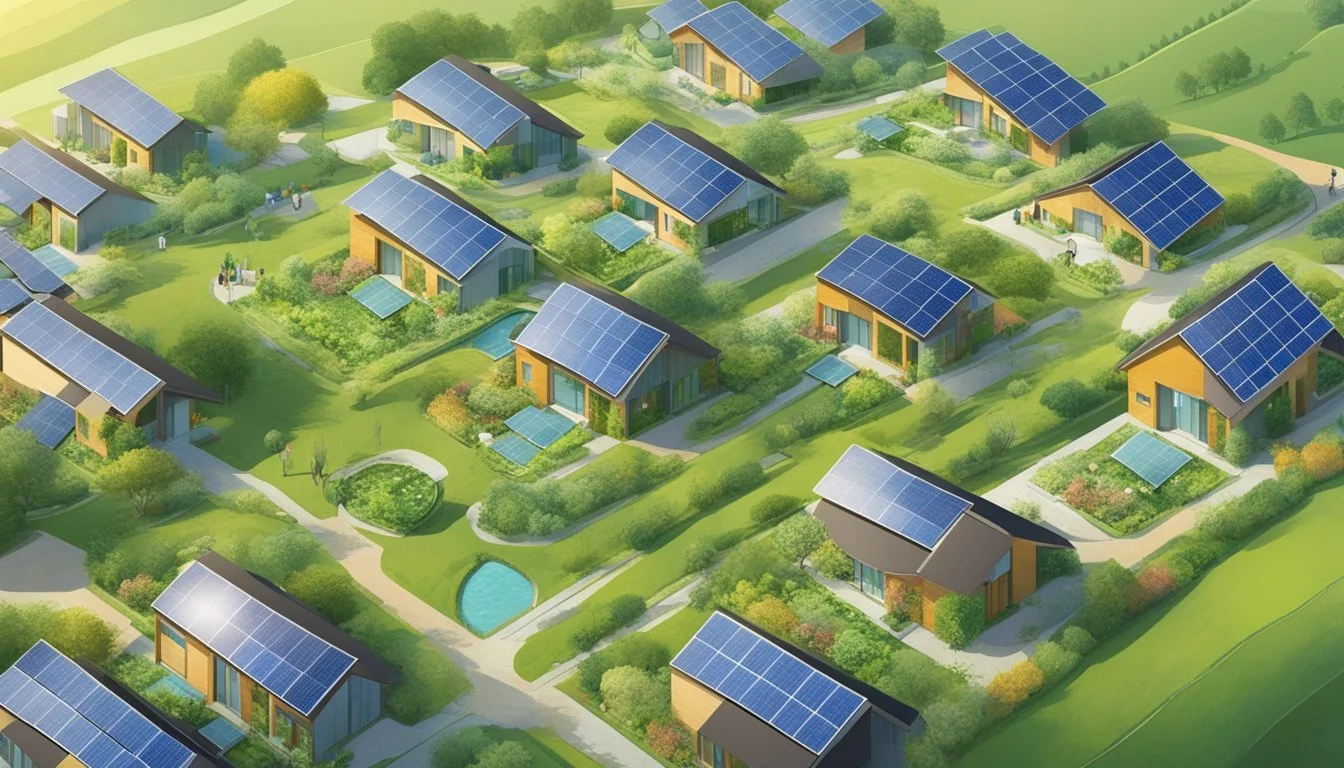Free Land for Eco-Villages
Steps to Building Sustainable Communities
Finding free land for eco-villages can be a compelling opportunity for those committed to sustainable living and community-driven initiatives. Several regions in the United States and beyond offer parcels of land to small groups dedicated to establishing eco-conscious, self-sustaining communities. This not only helps to preserve natural resources but also fosters a supportive environment where like-minded individuals can thrive.
Ecovillages such as Meadowsong EcoVillage in Oregon and Emerald Earth in California demonstrate the potential for creating durable, sustainable homes within a tightly knit communal framework. These communities emphasize ecological responsibility, education, and mutual support, presenting a rewarding lifestyle alternative for those looking to live off the grid. They form part of an ever-growing movement towards sustainability, paving the way for future green communities.
Globally, places like Eco Truly Park in Peru show diverse forms of ecovillage life, rooted in health, simplicity, and spirituality. Access to land in these regions can significantly lower barriers for new eco-villages, making the dream of a sustainable community a reality. Offering practical benefits and a sense of purpose, free land initiatives support the broader goals of environmental stewardship and community resilience.
Understanding Eco-Villages
Eco-villages are intentional communities aiming for sustainable living by integrating aspects like environmental care, social connection, and local autonomy. They focus on creating harmonious relationships among their inhabitants and with the broader ecosystem.
The Concept of Eco-Villages
Eco-villages represent a shift towards environmentally sustainable living. They combine modern and traditional methods to reduce ecological footprints.
Residents share common goals such as renewable energy use, waste recycling, and local food production. The aim is to live in harmony with nature while fostering a strong sense of community.
The Global Eco-Village Network
The Global Ecovillage Network (GEN) unites eco-villages worldwide, offering support and resources. GEN advocates for sustainable living models, providing a platform for sharing knowledge and best practices.
It connects eco-villages from different cultures, promoting diversity in sustainable living and fostering global collaboration and innovation.
Elements of Sustainable Communities
Sustainable communities incorporate several key elements. Environmental sustainability involves renewable energy, waste management, and conservation practices. Social sustainability emphasizes strong community bonds, inclusive decision-making, and shared responsibilities.
Economic sustainability focuses on local economies, resource efficiency, and self-reliance. Together, these elements create resilient and thriving communities.
Eco-Village vs. Traditional Communities
Eco-villages differ significantly from traditional communities. Traditional communities often prioritize economic growth, which can lead to environmental degradation and social isolation. In contrast, eco-villages emphasize sustainability, community engagement, and local resources.
Whereas traditional communities may struggle with pollution and waste, eco-villages implement systems to minimize these issues, fostering a healthier living environment.
The Intersection of Ecology and Society
The relationship between ecology and society in eco-villages fosters sustainable living environments that integrate ecological design, innovative governance models, and participatory community processes. These elements contribute to creating self-sustaining and socially cohesive communities.
Ecological Design and Architecture
Ecological design in eco-villages emphasizes sustainable architecture and green building practices. Homes and communal buildings are often constructed using materials with minimal environmental impact. Solar panels, rainwater harvesting systems, and geothermal heating are common, ensuring energy efficiency and resource conservation.
Permaculture principles guide the landscaping and agricultural practices, supporting biodiversity and food self-sufficiency. These design choices reduce the ecological footprint and create harmony with the surrounding environment. Eco Truly Park in Peru demonstrates this through its 18 conical houses, which blend traditional techniques with modern sustainability.
Social Structure and Governance
Governance in eco-villages typically involves community-based decision-making. Each member has a voice in how the village is run, fostering a sense of ownership and responsibility. This democratic process often includes consensus-based decision-making, which ensures that all viewpoints are considered.
Leadership roles may rotate or be shared to prevent power imbalances. Governance structures are designed to be flexible, allowing the community to adapt to changing needs and circumstances. This inclusive approach builds a strong social fabric and a collective identity among residents.
Community Building and Participatory Processes
Community building in eco-villages is centered on participatory processes that engage all residents. Regular meetings, workshops, and social events encourage interaction and collaboration. The shared work in communal gardens and projects strengthens bonds and fosters mutual support.
Shared resources and co-housing arrangements reduce costs and environmental impact. By living and working together, members develop a deeper connection to each other and their environment. This participatory approach not only enhances social cohesion but also promotes personal growth and a shared commitment to sustainability.
Environmental Impact and Climate Action
Eco-villages are at the forefront of sustainable living practices, making significant strides in reducing their carbon and ecological footprints, adopting organic farming practices, and integrating renewable energy solutions.
Reducing Carbon and Ecological Footprints
Eco-villages aim to minimize their environmental impact by reducing both carbon and ecological footprints. Carbon footprint is addressed by adopting energy-efficient technologies, reducing reliance on fossil fuels, and promoting public transportation and carpooling among residents.
Ecological footprint management includes sustainable construction materials, waste reduction, and recycling programs. These communities often design their infrastructure to maximize natural light and ventilation, which reduces energy consumption. Implementing permaculture principles helps create self-sustaining ecosystems that require fewer external resources and support biodiversity.
Organic Farming Practices
Organic farming in eco-villages focuses on sustainable agriculture methods that promote soil health and reduce the use of synthetic chemicals. Techniques such as crop rotation, composting, and natural pest control are commonly employed. This approach not only maintains soil fertility but also supports local biodiversity.
Many eco-villages integrate permaculture designs, which create resilient agricultural systems that mimic natural ecosystems. This encourages a diverse range of crops and reduces the need for chemical inputs, thereby lowering pollution and conserving water resources. Residents often participate in community gardens, ensuring fresh, local produce while fostering a strong sense of community.
Renewable Energy Integration
Renewable energy plays a crucial role in eco-villages, significantly reducing reliance on non-renewable resources. These communities often utilize solar panels, wind turbines, and geothermal energy systems to meet their energy needs. Solar panels are particularly favored for their ability to provide a steady supply of electricity and heat water.
Wind turbines are another common feature, especially in areas with consistent wind patterns. Geothermal systems help in maintaining a stable indoor temperature with minimal energy usage. By integrating these technologies, eco-villages not only cut down their carbon emissions but also pave the way for renewable energy adoption in broader communities.
Socio-Economic Paradigms and Sustainability
Socio-economic paradigms in eco-villages underscore the integration of economic models, sustainable food systems, and the promotion of art and culture in fostering a resilient community.
Economic Models for Eco-Villages
Eco-villages often employ cooperative and community-based economic models. These models prioritize shared ownership and democratic decision-making. Typically, they integrate local currencies and barter systems to reduce dependency on external economies.
Community-supported agriculture (CSA) is common, pooling resources for mutual benefit. In addition, many eco-villages establish social enterprises that focus on sustainability, such as renewable energy projects or eco-friendly manufacturing. This diversity offers economic stability and sustainability.
Sustainable and Ethical Food Systems
Food systems in eco-villages emphasize localizing production to enhance sustainability and reduce carbon footprints. Permaculture and organic farming practices are standard, promoting soil health and biodiversity.
They often produce locally grown food, minimizing transport emissions and supporting local economies. Community gardens and farmers' markets are central, creating a direct supply chain from producer to consumer. These practices ensure food security, ethical production, and community well-being.
Art, Culture, and Education
Art and culture play a vital role in the social fabric of eco-villages. Cultural activities and artistic expression foster community spirit and preserve local heritage.
Educational programs focused on sustainability, such as workshops and courses on eco-friendly practices, are common. These programs empower residents with the knowledge to maintain and further develop sustainable living practices. Local festivals and cultural events often celebrate these initiatives, reinforcing community ties and shared values.
Case Studies: Successful Eco-Villages
Eco-villages around the world serve as models of sustainable living, blending environmentally-friendly practices with community-focused development. This section explores notable examples, including Findhorn Eco-Village in Scotland, Eco Truly Park in Peru, Crystal Waters Eco Village in Australia, and The Farm in Tennessee.
Findhorn Eco-Village, Scotland
Findhorn Eco-Village is a pioneering sustainable community located in northeast Scotland. Established in the early 1960s, it emphasizes spiritual sustainability alongside environmental practices.
The village incorporates renewable energy systems, such as wind turbines and solar panels. Residents participate in innovative waste management and organic farming.
Findhorn also supports educational programs, hosting workshops on eco-friendly living and community building. Communal decision-making and shared resources play a crucial role in maintaining the harmonious lifestyle of its residents.
Eco Truly Park, Peru
Eco Truly Park, situated near Lima, Peru, is a vibrant eco-village known for its distinctive architecture and spiritual foundation. The village buildings feature unique trullo-style structures made from adobe, known for their eco-friendliness and thermal efficiency.
The community focuses on sustainable agriculture, using organic farming techniques to cultivate a variety of crops. Visitors are invited to participate in daily activities, including yoga and meditation sessions, fostering a holistic approach to sustainability.
Eco Truly Park places a strong emphasis on artistic expression and cultural exchange, making it a hub for both environmental and spiritual enrichment.
Crystal Waters Eco Village, Australia
Located in Queensland, Australia, Crystal Waters Eco Village covers 650 acres, making it one of the largest eco-communities worldwide. Established in 1985, it is designed based on permaculture principles, emphasizing sustainable land use and self-sufficiency.
The village boasts extensive rainwater collection systems, composting toilets, and renewable energy installations. Residents are deeply involved in agriculture, producing much of their own food through communal gardens and orchards.
Crystal Waters supports a variety of local businesses, from bakeries to arts and crafts, reinforcing the community’s economic independence and innovative spirit.
The Farm, Tennessee
The Farm in Tennessee, founded in 1971, is one of the most well-known intentional communities in the United States. Originally a communal living experiment, it has evolved into a self-sustaining eco-village with a strong focus on environmental stewardship.
The Farm employs solar energy, organic farming, and green building techniques. It also runs educational programs and outreach initiatives, sharing its model of sustainable living with the broader public.
The community emphasizes principles of non-violence, ecological responsibility, and cooperative living, making it a lasting example of intentional, eco-conscious development.


